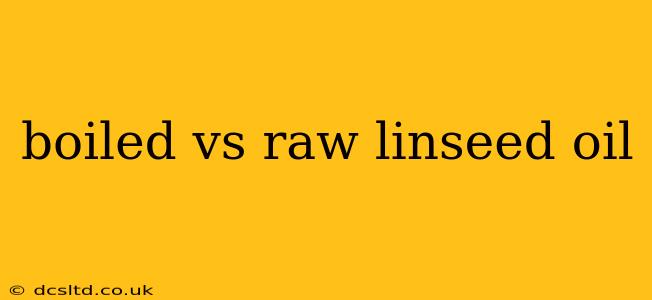Linseed oil, extracted from flax seeds, is a popular drying oil used in various applications, from painting and varnishing to wood finishing and even skincare. However, the terms "boiled" and "raw" linseed oil can be confusing. This article will clarify the differences between these two types of linseed oil, outlining their properties and best uses. Understanding these distinctions is crucial for choosing the right oil for your specific project.
What is Raw Linseed Oil?
Raw linseed oil is unprocessed linseed oil, meaning it hasn't undergone any heat treatment or chemical alteration. It retains all its natural properties and components, including its slower drying time. This slow drying time, while sometimes a drawback, allows for deeper penetration into wood, offering superior protection and water resistance in the long run.
Advantages of Raw Linseed Oil:
- Deep penetration: Raw linseed oil soaks deeply into wood, nourishing it from within.
- Natural properties: Retains all the natural components of flaxseed oil, beneficial for both wood and skin (with caution).
- Excellent for food-safe applications (with proper curing): When fully cured, it is safe for use on surfaces that may come into contact with food.
Disadvantages of Raw Linseed Oil:
- Slow drying time: Can take days or even weeks to fully dry, depending on the environment.
- Susceptible to oxidation and rancidity: If not stored properly, it can go rancid.
What is Boiled Linseed Oil?
"Boiled" linseed oil is a misnomer. It's not actually boiled; instead, it's processed using heat and/or metal catalysts to speed up its drying time. This process alters the chemical composition slightly, making it dry much faster than raw linseed oil. It often contains driers, such as metallic salts (like cobalt, manganese, or lead), that accelerate the oxidation process.
Advantages of Boiled Linseed Oil:
- Fast drying time: Dries significantly faster than raw linseed oil, often within hours.
- Improved durability: The added driers can enhance the durability and water resistance of the finished product.
Disadvantages of Boiled Linseed Oil:
- Less penetration: The driers can prevent the oil from penetrating as deeply into wood.
- Potential toxicity concerns (lead-based driers): Older formulations may contain lead, making them unsuitable for food-safe applications. Always check the label for safety information.
- Yellowing over time: Can yellow more quickly than raw linseed oil.
What is the Best Linseed Oil for Wood Finishing?
The best linseed oil for wood finishing depends on the project and your desired outcome.
-
For deep penetration and long-term protection: Raw linseed oil is ideal. The slower drying time allows for better absorption, leading to superior water resistance over time. This is especially beneficial for fine furniture or wooden items where longevity is crucial. Be prepared for a longer drying and curing process.
-
For faster drying and convenience: Boiled linseed oil is the better option. Its faster drying time is more convenient for projects where speed is essential. However, the trade-off is slightly less penetration and a potentially quicker yellowing.
How Long Does Boiled Linseed Oil Take to Dry?
Boiled linseed oil typically dries to the touch within a few hours to overnight. However, full curing, where it becomes completely hard and resistant to water, can still take several days, depending on factors like temperature, humidity, and the thickness of the applied coat.
Is Boiled Linseed Oil Toxic?
Modern boiled linseed oil formulations are generally considered safe when used as directed. However, older formulations might contain lead-based driers, which are toxic. It's crucial to check the label and choose a product from a reputable manufacturer that explicitly states it's lead-free. Always work in a well-ventilated area, wear gloves, and follow safety precautions on the product packaging.
Can I Use Boiled Linseed Oil on Food Contact Surfaces?
It's generally not recommended to use boiled linseed oil on surfaces that come into contact with food, especially if the product contains metal driers. Even lead-free options might not be entirely safe after curing. For food-safe finishes, consider using other food-grade oils or sealants specifically designed for such applications.
By understanding the distinctions between raw and boiled linseed oil, you can select the appropriate oil for your specific application, ensuring the best results and safety. Always follow the manufacturer's instructions carefully.
